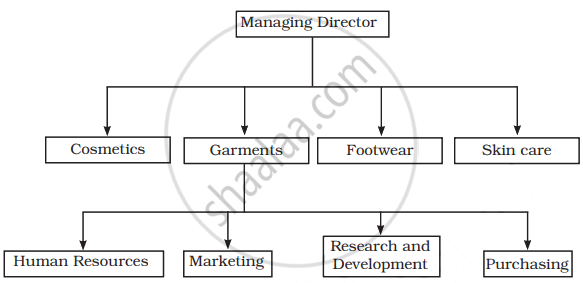Advertisements
Advertisements
प्रश्न
Differentiate between formal and informal organization on the basis of the following:
Meaning
उत्तर
| Basis for Difference |
Formal Organisation | Informal Organisation |
| Meaning | Organisational structure which is designed by the management to accomplish a particular task. It specifies the boundaries of authority and responsibility and there is a systematic coordination to achieve organisational goals |
Interaction among people at work gives rise to a network of social relationships among employees. It emerges from within the formal organisation when people interact beyond their officially defined roles. |
संबंधित प्रश्न
'Steelo Ltd.' decided to set-up its steel manufacturing factory in the backward area of Orissa where very less job opportunities were available. People of that area welcomed this effort of 'Steelo Ltd.' To attract people to work in its factory it also decided to provide many other facilities like school. hospital. market etc. in the factory premises. 'Steelo Ltd.' started earning huge profits. Another competing company asked its production manager 'Aslam' to investigate the reasons of earning huge profits by 'Steelo Ltd.' Aslam found that in both the companies there was systematic coordination among the various activities to achieve organisational goals. Every employee knew who was responsible and accountable to whom. The only difference was that in his organisation communication took place only through the scalar chain whereas 'Steelo Ltd.' was allowing flow of communication in all the directions as per the requirement which lead to faster spread of information as well as quick feedback.
a. Identify the type of organisation which permits 'Steelo Ltd.' the flow of communication in all the directions.
b. State another advantage of the type of organisation identified in (a) above.
c. State any two values which 'Steelo Ltd.' wanted to communicate to the society
State its any two advantages of the functional structure
State any three limitations of divisional structure of an organisation.
Differentiate between formal and informal organization on the basis of the following:
Origin
The differential between 'Functional and 'Divisional' structure of organising on the basis of the
following:
Formation
A differential between 'Functional and 'Divisional' structure of organising on the basis of the following:
Specialisation
A differential between 'Functional and 'Divisional' structure of organising on the basis of the following:
Cost involved
How does informal organisation support the formal organisation?
Answer the following question.
Voltage fluctuations have been common and quite high in India. They harm our electrical appliances like televisions, refrigerators, and air conditioners, often leaving them in a permanently damaged condition. N-Guard Company decided to manufacture stabilizers for North India where the voltage fluctuation ranges from 220 V to 230 V. Once the demand for North India was taken care of, they decided to launch stabilizers of varying voltages from 90 V – 260 V for meeting the requirements of voltage fluctuations in other regions of India also. Three engineers were appointed for South, West and East regions of India, as the voltage was different in all the three regions.
Though all the engineers were appointed to manufacture stabilizers but the product differed from region to region.
(a) Identify the organisational structure of the N-Guard Company.
(b) State any two advantages and two limitations of the structure identified in the above para.
A tall structure has a ____________.
Uranus Limited is a company dealing in metal products. The work is mainly divided into functions including production, purchase, marketing, accounts and personnel. Identify the type of organisational structure followed by the organisation.
Which of the following is not a merit of functional structure?
Which type of organisational structure will you suggest for a firm which has diversified activities and operations requiring a high degree of specialisation?
Grouping of activities on the basis of functions is a part of
______ ensures that the heads of separate business units in the organisation are responsible for profit or loss of their unit and have authority over it.
Which of the following is a disadvantage of divisional structure?
Yummy Foods Ltd. has its registered office in Lucknow, manufacturing unit in Kanpur and marketing department in Chandigarh. ______ type of organisational structure should be adopted by the company to achieve its objectives.

Identify the type of organization structure depicted in the above diagram:
| Diligent developers, a website design company in Bangalore is a startup initiative of Mr. Maniraj which aims at achieving a profit margin of 10% in its first year. Mr. Maniraj appointed Mr. Advait as the Digital marketing Head, Mr. Kiyansh as the head of the Backend department and Mr. Nirved headed the Graphics Designing Department. Since each head was specialised in specific skills, it resulted in increased efficiency and better coordination. However, problems arose when Mr. Advait started considering group objectives superior to organisational objectives and stopped exchanging information with Mr. Kiyansh and Mr. Nirved. The company had to bear the brunt of a lack of coordination and was unable to achieve its objectives. |
- Identify and state the organisational structure adopted by the company.
- State two benefits and two limitations of the identified structure highlighted in the above case.
